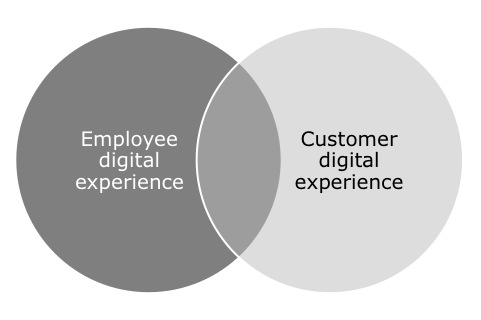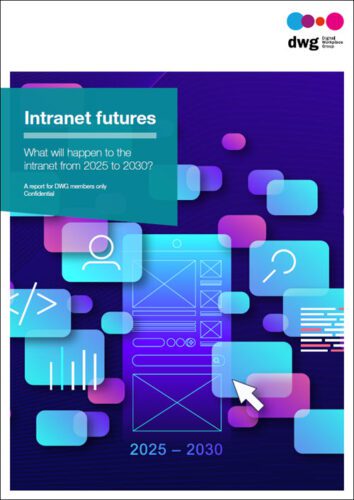My top ten intranet and digital workplace predictions for 2014
[intro]Paul Miller, CEO and Founder, Digital Workplace Group and author of “The Digital Workplace – How Technology is Liberating Work”, tells us what will happen in the accelerating digital workplace industry globally in 2014.[/intro]
It is clear that in 2013 not only did intranets increase their velocity and criticality for any modern organization (with widespread upgrades, investment and expansion) but the digital workplace came of age and became an accepted, essential digital and work reality.
So what can we expect for intranets and the digital workplace 2014?
Trend 1 – Across intranets, collaboration and the wider digital workplace the emphasis will be on robust execution, stable connection and enterprise systems that actually work 24/7.
For so many large organizations, the challenge is not digital innovation (we already have so many transformational services) but the fact that the delivery and operation of services is patchy, fragmented and unreliable. The focus for intranet, technology and digital teams will be (and must be) on giving stable access to fast services for all staff and contractors – and most corporates have a long way to go. The notable exceptions (not surprisingly given their staff location and services) are the likes of PwC and Accenture. But if you are an oil company this connectivity starts to unravel when you have engineers in remote locations or countries with weaker digital infrastructure.
Trend 2 – Digital workplaces will extend the connections between staff and customers – and blur the line between “inside” and “outside” the modern digitized organization.

The UK postal service, Royal Mail, has an intranet that staff can access easily via the internet. South West Airlines has a large team who blog and post content to customers and intranet-enabled employees equally to align messages internally and externally. Suncor Energy integrates its Facebook and Twitter feeds into the homepage of its intranet so staff can see what the market is saying about them. What each of these examples shows is that the line between the internal and external is blurring. This trend will continue in ever more innovative forms.
Trend 3 – The reach of intranet and wider digital workplace services will embrace the “digitally disenfranchised”, with dramatic, empowering consequences.
Those left in the “digital cold” by the previous technology waves will be swept up in the latest shifts as staff who never had access to data, knowledge (and therefore power) gain this in the palm of their hands via mobile phones and tablets. Retail staff, field engineers and remote location operators (oil rigs or agricultural, for example) will find digital services tailored for them. Barclays has pioneered this in retail finance with lovely apps for branch staff in the UK and (next) South Africa, while Virgin America’s VX Connect platform, designed for the 90% of staff who do not have a desk, looks as gorgeous as the airline’s brand advertising.
Trend 4 – Intranet, collaboration and digital workplace managers and teams will be front and centre for the “C Suite” leadership because they have rare skills.
Gartner has predicted that a new wave of roles – chief digital officer, chief digital strategy office and chief data officer – will be created to plug the huge strategic digital gap organizations face. CEOs are looking around for individuals who can help transform their businesses digitally – and the people who manage intranet, collaboration and digital workplace services now have all the skills to seize the moment. It’s time for intranet teams and the ambitious professionals within them to make their presence felt in a way that C-level leaders will notice.
Trend 5 – The social intranets phase is now “business as usual” – but the participatory, conversational model will extend its reach.
Aviva led the way in financial services staff dialogue, with consistently high adoption of its social tools seen as a barometer of employee sentiment by senior management. “Buzz” is ING’s leadership communication network, championed by its enthusiastic CEO blogger Nick Jue, and attracting 100-plus comments on some posts. PNC runs “Ideabank” for employees to generate innovation. 6,000 ideas were submitted in the first eight months, which could be rated by colleagues. The instant channels of conversation and exchange that the wider digital workplace offers form an unstoppable trend to “get involved”.
Trend 6 – Beauty, fabric and texture in digital enterprise services will drive adoption.
Steve Jobs invented the idea that the digital world could be a beautiful place where we loved to go. His legacy meant that when Virgin Media launched its new digital workplace on Cisco Social the adoption and engagement rates were exceptional, due in no small part to the richness of the digital experience and the simplicity of its interface. Instant video-calling from within the advanced intranet and the ease of colleague-to-colleague access produced a stunning environment. When Adobe launched “Inside Adobe” using its own technology platform, the beauty of the site took the industry’s breath away – love at first sight! The texture of what we create will matter more and more.
Trend 7 – Training, hand-holding and patience will characterize success stories for new intranet, collaboration and digital workplace roll-outs.
What we hear, again and again, is that organizations who take time to sit down with staff and train them to use new digital workplace tools and functionality gain hugely in adoption. When Barclays delivered its mobile platform, “MyZone”, to its retail teams it appointed 1,000 “digital eagles” to guide staff through the new services, even though the whole experience was simple and intuitive. Staff now use this same training to get customers mobile within a few minutes when they visit a branch. Virgin Media used a similarly hands-on approach for the roll-out of its own mobile platform. There are no short cuts – holding someone’s hand while they use the new services works.
Trend 8 – The “revenge of the office” will be felt through new physical workplace formats.
IBM used to be called “I’m By Myself”, as staff felt so isolated from colleagues due to home working. So the company started trying to attract staff back to shared spaces. One liberating effect of the digital workplace is that it allows people to decide where and how they work. However the office will continue to fight back by offering experiences we cannot get anywhere else – colleagues available in person, better technology, better food and lifestyle services. The pattern overall will be one of more numerous corporate physical workplaces – but situated closer to where people live, as the pain of commuting will seldom be offset by free food and nice collaboration spaces. Unilever’s “Agile Working” programme has re-designed offices but also given staff the power to choose where they work.
Trend 9 – Advanced intranets will integrate publishing and collaboration in one environment.
AMP in Australia allows every employee to publish news so that all content becomes a conversation. Coca-Cola Enterprises brings HR processes to the homepage alongside communication and collaboration – nicely delivered to mobile devices. Increasingly the current fragmentation of services and devices will be eroded (only partly in 2014, as it’s a longer term task). The services we use most will be presented in a single integrated digital world in a similar way on the desktop, mobile or in the enterprise cloud.
Trend 10 – Leadership will increasingly treat the digital workplace as the digital backbone for its leadership style and impact.
The ability of CEOs to sit at their desk, in a café or on a train and communicate not only with staff but their supply chain, partners, customers and the media will be seen increasingly as a critical skill. The speed, impact and reach of the digital workplace through services like Yammer, Twitter, blogging, commenting, podcasting and video messaging is a jewel in the crown of any “C Suite” leader. From celebrated cult figures like Salesforce.com CEO Marc Benioff to quieter but no less effective leaders like Nick Jue from ING, digital channels will be the most potent way to effect change in an organization and its marketplace.
Categorised in: Digital workplace
